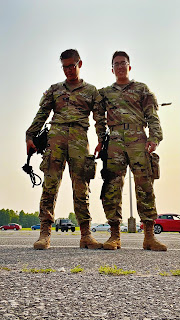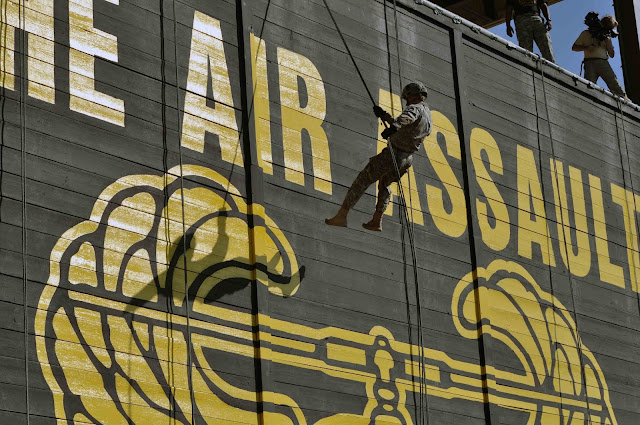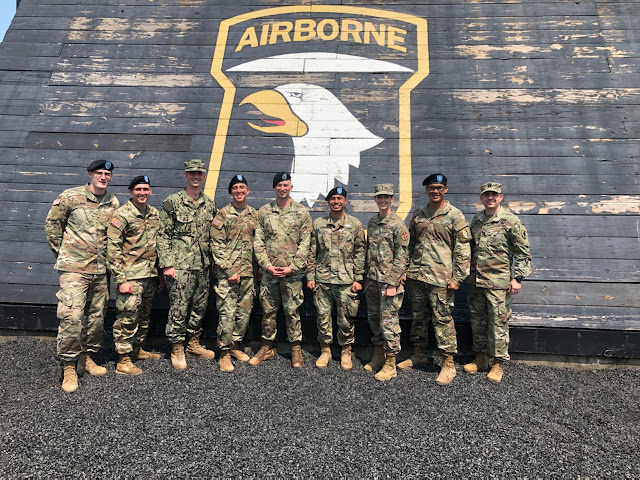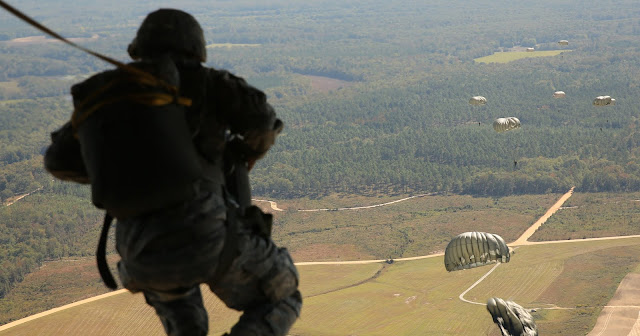Uniformed Services University Medical Students Earn Coveted Air Assault, Airborne Badges
By Sarah Marshall
Uniformed Services University of the Health Sciences (USU) medical students recently had an opportunity to complete some of the military’s most challenging training, and they jumped for it -- literally -- earning themselves the coveted “jump wings” and the distinguished Air Assault badge.
Eight students, currently starting their second year of medical school, voluntarily and successfully completed the Army’s Air Assault School and the Army Basic Airborne course. The 10-day Air Assault School is located at Fort Campbell, Kentucky, and trains service members on missions performed by rotary wing aircraft, on aircraft safety, aero-medical evacuation procedures, pathfinder operations, and combat assault techniques. Upon completion, service members are awarded the Air Assault badge, which stands out with a helicopter at the center. The Army’s three-week Basic Airborne course, located at Fort Benning, Georgia, teaches the techniques of parachuting from airplanes, and is also designed to challenge service members both physically and mentally. Upon completion, service members are considered a paratrooper and awarded the Parachutist badge, or the symbolic “jump wings.”
 |
| 2nd Lt. Joseph Tang (left) and 2nd Lt. Christopher Kohama, second-year medical students at USU, recently earned their Air Assault badge over the summer. (Courtesy photo) |
These highly motivated students began to prepare about three months before the training. This involved doing at least one or two “rucks” each week, a long walk carrying 35 pounds of gear on their backs. As part of Air Assault School, a 12-mile ruck is required and must be completed in less than three hours. They also coordinated with a local gym that specializes in high-intensity training, where they went through several rope climbing practice sessions. Additionally, they worked with the USU School of Medicine’s Army company command to organize an obstacle course and a rope climb at Fort Belvoir. They also had support from other cadre at USU, who previously completed this training and passed on tips before they set off for the training.
While they all did their best to get ready for grueling military instruction, many of the students said what really got them through it was the support of their classmates, and an inner drive to keep challenging themselves.
For Pickering, who had no military experience prior to coming to USU, Air Assault School reminded him of the overall mission of the military, and gave him affirmation that the military is where he belongs.
“Those two weeks at Fort Campbell greatly developed my military cultural competency,” he said. “And it gave me more confidence to not only be a better officer, but also a better care provider to hard working service members.”
Mount said that the training allowed her to learn more about her future patient population. She said it helped her conceptualize the physical challenges she could potentially face if she were to be attached to a high-performing unit down the road. Mount, who has an interest in operational medicine, also said the training taught her how to take care of herself and her future patients in terms of soreness, exhaustion, and blisters. She learned what the body needs nutritionally in that environment, and how to avoid heat casualties.
“I kept a mental note of what injuries I may expect to see in that kind of environment, as well as preventive measures and education points to optimize performance,” she said. Mount added that she also personally enjoyed the “rucking.”
“I was able to switch from the mental challenge of learning medicine to a physical one, while spending time outside with my friends,” she said.
Like her peers, Mount did everything she could to take care of herself, physically and mentally, in hopes of representing USU well.“There were only a few women in my class, and one other Airman, so that gave me the extra push to be sharply disciplined and put my best foot forward. I was determined to prove myself and get the wings,” she said.
Cuevas, who has a shared interest in operational medicine, likened the training to medical school -- both requiring mental toughness. What got him through Air Assault School in part, he said, was some advice from one of his Air Assault instructors: it’s easier to get through if you stay motivated. He believes that by staying motivated, and keeping a positive attitude, he also impacted others around him.
 |
| A 101st Airborne Division soldier rappels down the side of the Air Assault School's 34-foot tower during a 2012 competition. Several medical students from the Uniformed Services University recently completed Air Assault School, earning their Air Assault badge. [Photo by Sgt. Grant Matthes, 101st Airborne Division (Air Assault)] |
Cuevas said he volunteered for the specialized summer training out of his desire to overcome challenging tasks, and to be a part of something larger than himself. It also was a chance to gain a better understanding of, and appreciation for, nonmedical aspects of the Army, and how different units intimately work together towards a shared mission, which he believes will be of value in his career in military medicine.
“This deeper understanding will better allow me to advise as a military medical physician,” he said, adding that it also brings him one step closer to being an excellent military doctor.
Like Cuevas, 2nd Lt. Berk said he enjoys challenging himself mentally and physically, and Air Assault School was a good way to do that. Berk, who served as a medic in the National Guard and an Army flight medic prior to coming to USU, said the training was also about personal growth. He also said that the thought of being able to connect with future patients via the Air Assault badge helped motivate him throughout the course.
“For me, Air Assault School was significant because it is a traditional Army training experience, which I got to share with great friends,” he said. “That’s significant on a personal growth level, but I’m also hoping that it will help me better relate to my patients in the future.”
Tang shared similar sentiments.
“As an endurance athlete, I considered the physical challenges of Air Assault School not as mere hurdles to overcome on the path to earning my wings, but as opportunities to push my personal limits,” he said.
Tang also said he “couldn’t shake the feeling” that he has been missing out on a crucial component of service, namely the practical skills and discipline that his fellow Soldiers go through. Air Assault School was also the perfect opportunity for him to take a step back from the books and transcend from his role as an officer.
The experience was unlike any other, Tang added, where he would “ruck” alongside an enlisted private second class, and then later do pull-ups with a lieutenant colonel, all on the same day. This fostered an inner-rank camaraderie in a unique way. The program also gave him most likely the only chance he would get to rappel out of a helicopter, he said.
Earning their ‘jump wings’
In addition to those who earned their Air Assault badge, four students earned their Airborne badge this summer: Army 2nd Lt. Som Chaturvedi, 2nd Lt. Esther Kim, 2nd Lt. Matthew McDonough, and 2nd Lt. Julius Shepard.
Kim said the training itself was rigorous, both physically and mentally, and there were some days she questioned her choice to volunteer for the program, especially jumping out of an aircraft, she said. But having her classmates to unwind with at the end of each day was beneficial and ultimately helped them all successfully complete their courses.
Prior to coming to USU, Kim provided medical coverage for the Ranger and Airborne schools, serving as an enlisted Army medic at Fort Benning. She always wanted to go through the training herself, and once she had the opportunity to go for it, she did not hesitate.
“I want to be a well-rounded medical officer who has the qualifications and the understanding of what some of our Soldiers go through,” she said.
While she is proud of earning her “wings,” Kim credits the support of the USU Brigade, and the enlisted Soldiers who went through this training alongside her as motivation.
 |
| Several USU students, currently starting their second year of medical school, recently completed the Army Air Assault course, earning their coveted air assault wings. (Courtesy photo) |
“Attending these trainings is what separates us as military physicians and makes us officers,” McDonough added.
Prior to completing the Army Basic Airborne Course, McDonough said he did some heat acclimation and a lot of running. And while he prepared physically, his faith also helped him through.
“Stepping up to the door of a high-performance aircraft terrified me to no end, but I knew that God would get me to the ground safely,” McDonough said.
Like his classmates, McDonough was grateful for the opportunity and proud of the accomplishment.
“It reminded me that I am not only a future military physician, but a military officer as well,” McDonogh said. “I am grateful to have attended the school and hope to attend more in the future.”





